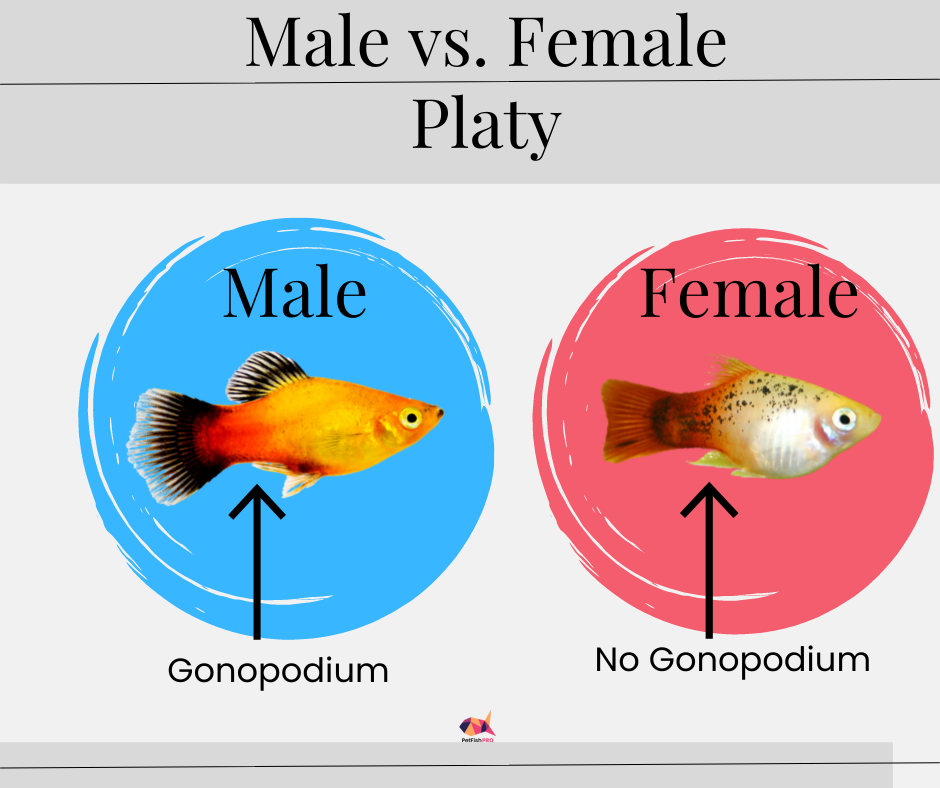It’s relatively easy to tell male and female platies apart. The main difference between male and female platies are that the male platies have a modified anal fin called the gonopodium. While female platies don’t have a gonopodium. Gonopodium resembles a long anal fin. Below you will find four easy ways to tell male and female platies apart.
Four Ways to Tell Male and Female Platies Apart
1. Male Platies Have Long Anal Fins (Gonopodiums)
The easiest and surest way to tell male and female platy apart is to look for the gonopodium. Like other male freshwater livebearers, male platies have a modified anal fin called a gonopodium. While female platies don’t have a gonopodium.
Gonopodiums look like long, pointy anal fins (anal fins are the fins at the bottom of the fish). Male platies have a gonopodium, while female platies don’t have a gonopodium. The anal fins of female platies look rounded.
2. Female Platies are Fatter and Bigger than Male Platies
Another way to tell male and female platies apart is to look at the size of the platies. Female platies are fatter, rounder, and bigger than male platies. Take a closer look at your platies. The bigger and fatter platy is probably the female. Verify the sex of your female platy, check that she does not have a gonopodium and that her anal fins are rounded and short.
3. Female Platy Have Rounder Belly with a Black Spot
Look for rounded bellies and a black spot on the belly to distinguish between male and female platies. If your female platy is pregnant, she will have a big round belly and a big black spot on her belly. The black spot on the belly of the female platy is called the gravid spot.
Even if the female platy is not pregnant, you can still see the black spot on the belly. The gravid spot may not be as dark and prominent on the female platy’s belly if she’s not pregnant, but nevertheless, there will be telltale signs of the black spot.
Just look closely at your platies. You will see the black, gravid spot on the belly of your female platies. Verify that she is indeed a female platy by also checking to see that her anal fin is round and that she doesn’t have a gonopodium.
Male platies, on the other hand, will not have any signs of a black spot on their belly. The belly of male platies will also look thin. Verify that your male platies are truly male by checking to see if their anal fins are long and pointy, which tells you he is a male platy because he has a gonopodium.
4. Male Platy’s Coloring is More Vibrant than the Female Platy
Another, more subtle way to tell apart male and female platy is to look at the coloring of the platy fish. The male platy will be more vibrant in color when compared to the female platy. It’s not obvious at times since it can be difficult to discern between one shade of orange and another shade of orange.
Using this method alone to tell apart male and female platy fish will not be accurate. You should also double check the sex of your platy by looking for the gonopodium, comparing the size and looking for the gravid spot.
How to Tell Young Male and Female Platies Apart?
When they are young, all platies look like female platies. It’s difficult to tell apart young male and female platies because they look similar. One way to tell apart male and female juvenile platies is to look for the gonopodium.
Look closely at your young platies. Look for the tell-tale signs of gonopodiums on male juvenile platies. They look like pointy anal fins. However, sometimes, if your platies are really young, they may not have their gonopodiums yet.
Keep checking your young platy. Eventually the gonopodium will emerge and you will be able to tell the young female platy apart from the young male platy.
Can Platies Change Sex?
No, platies don’t change sex. If they are born female, they will not change sex to a male. Female platies will remain female for life. The same holds true for male platies. If they are born as male platies, they will stay male for life.
Some fishkeepers get confused and mistakenly think their female platy has changed sex to become a male platy. This confusion frequently occurs when a male platy dies or is removed from the tank, and the female platy becomes pregnant despite the fact that there are no male platies in the tank.
This pregnancy occurred because the sperm of the male platy stayed inside the female’s body. A female platy can store male platy sperm in her body for months, so the female can get pregnant again even if the male platy is not present.
Quiz: Spot the Male versus the Female Platies
After reading this article, I hope you learned to tell the difference between male and female guppies. Take the quiz below, find out if you can distinguish between male and female guppies.
Take a look at the photo below, can you spot the male platy? Do you see the long and pointy gonopodium on the male platies? Do you see the rounded anal fins of the female platies?
You May Also Be Interested In:
How to Tell Male and Female Swordtails Apart (Infographic)
How Many Platies in a 10 Gallon Tank? (Calculator for 10,20,30 Gallons)

